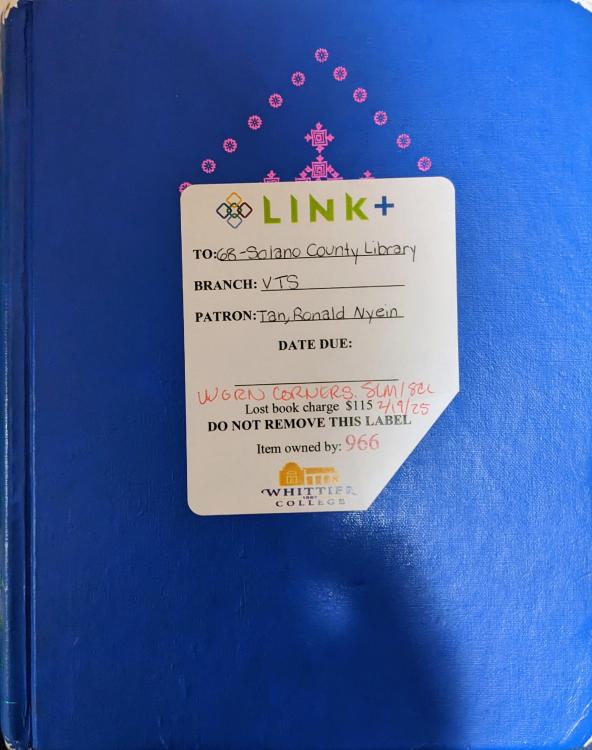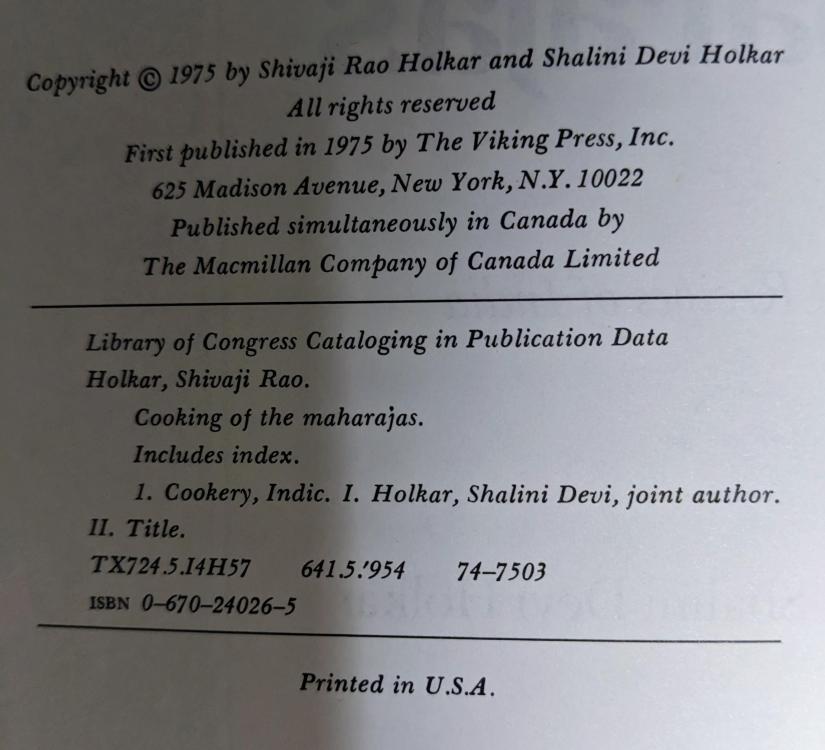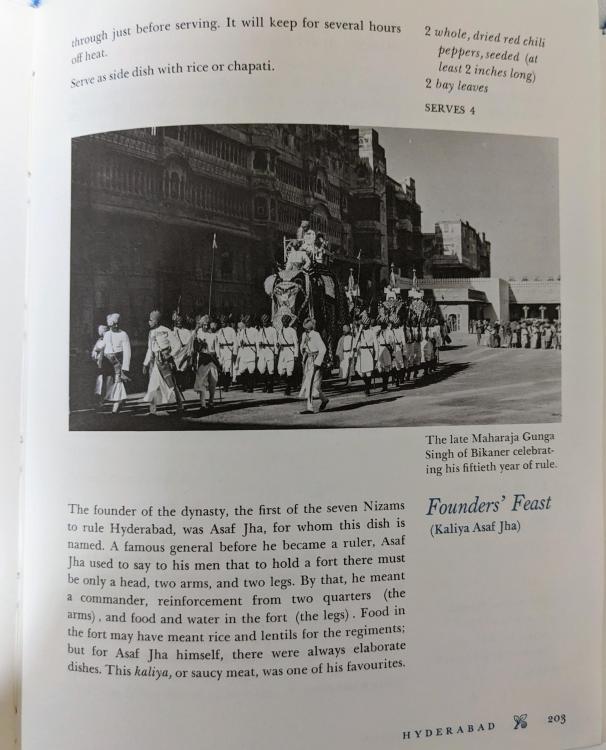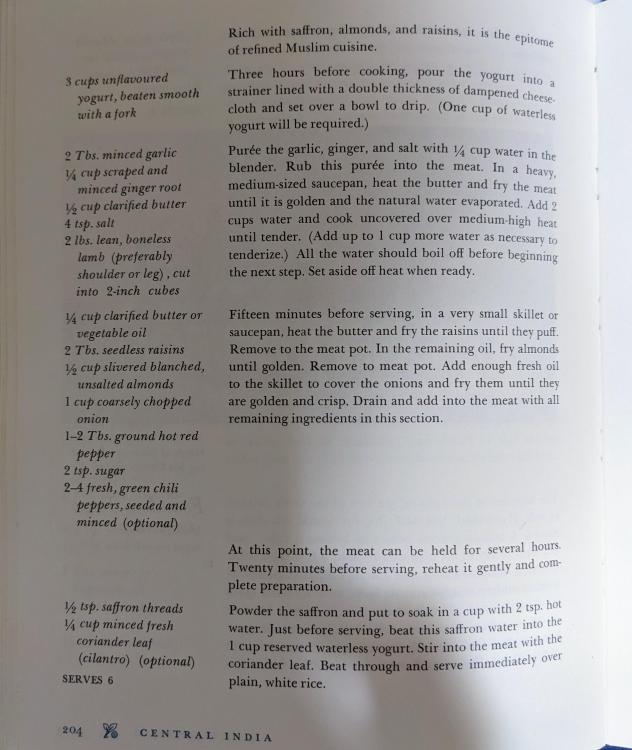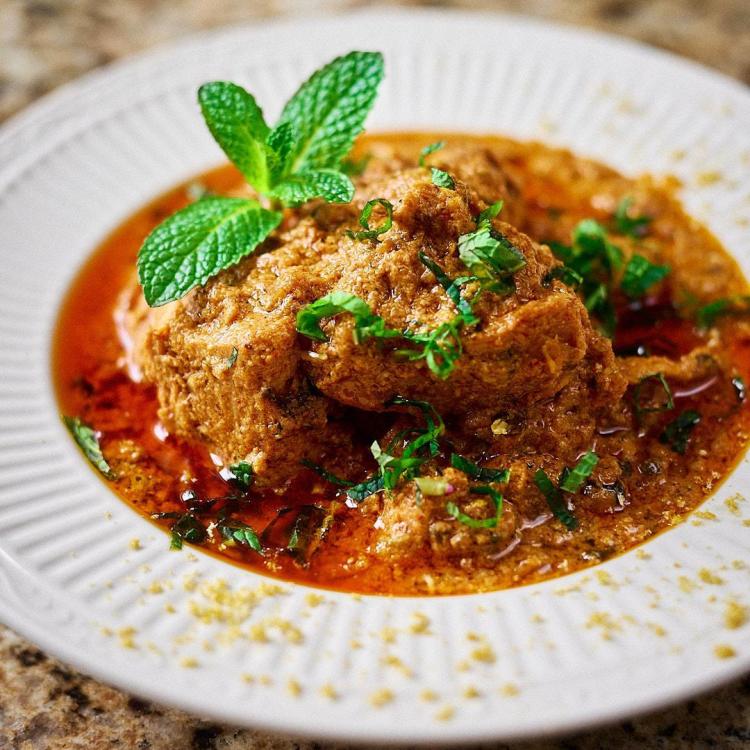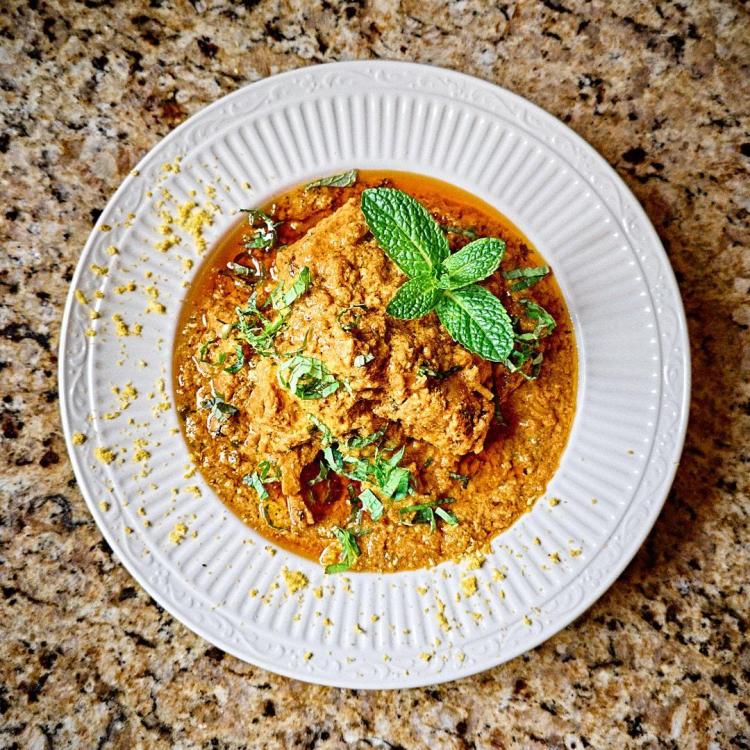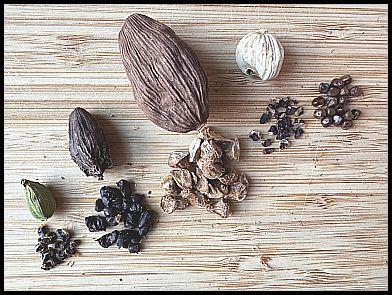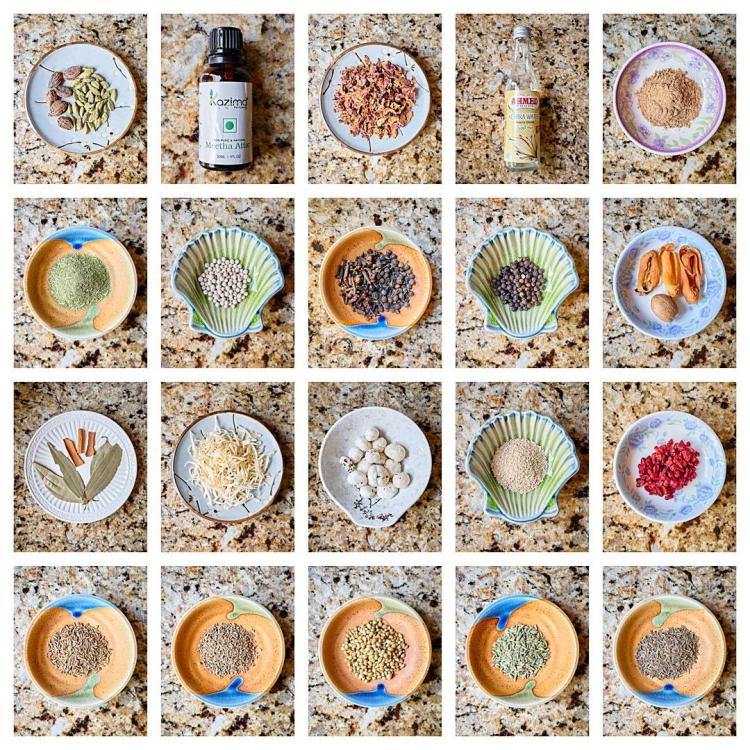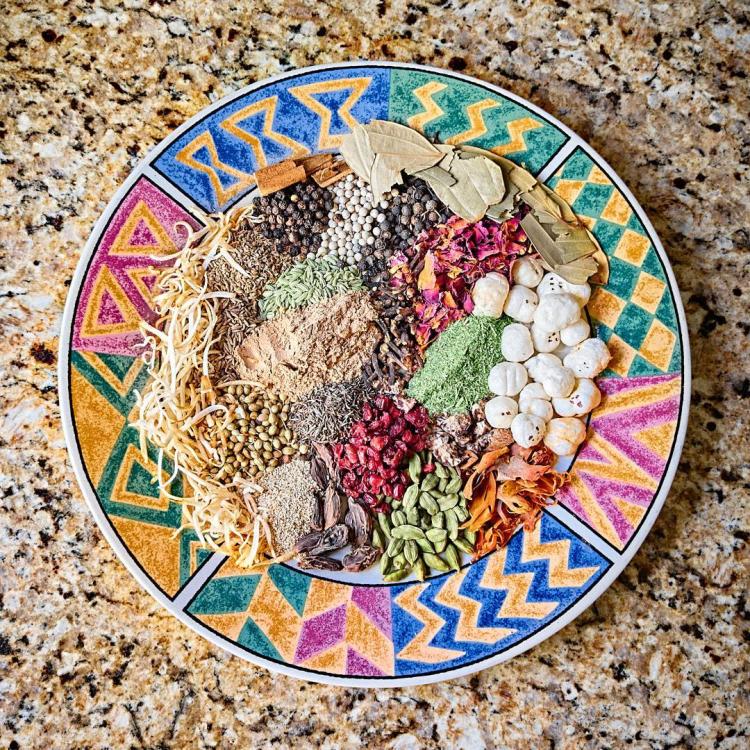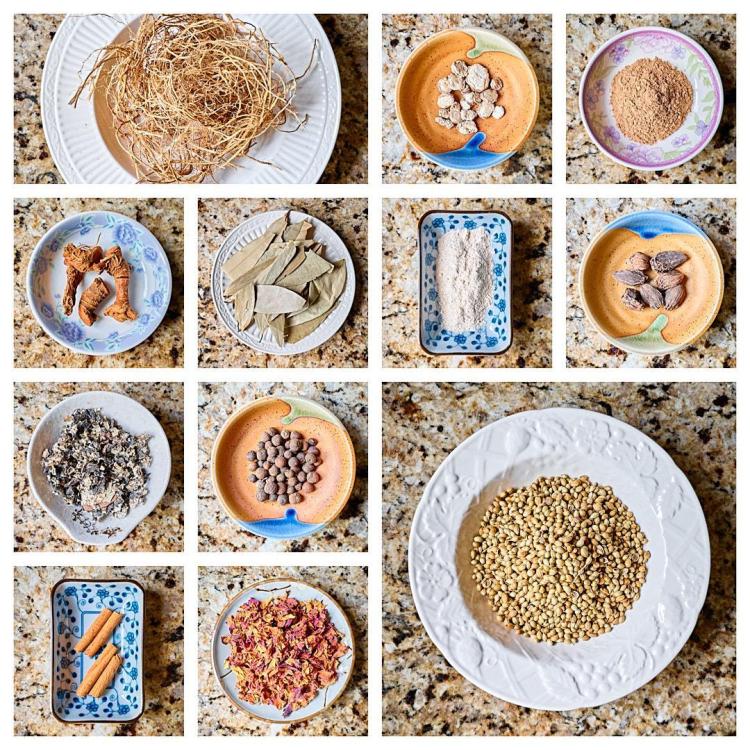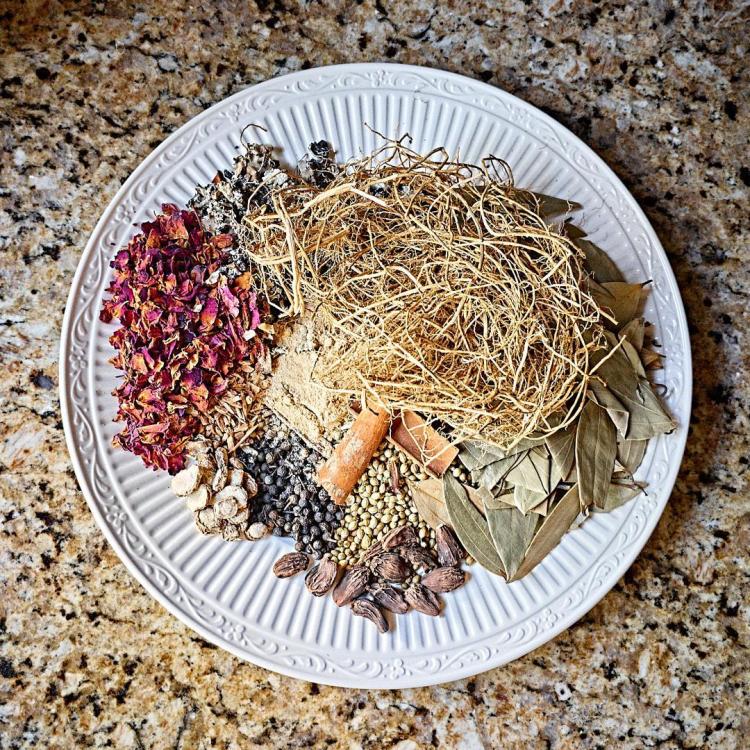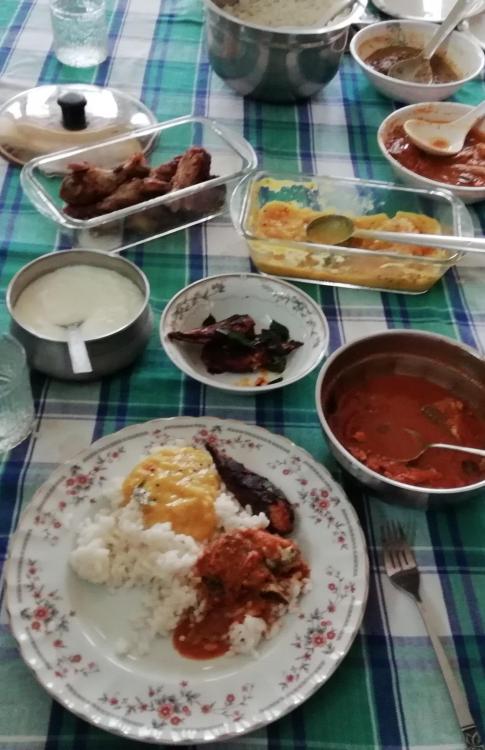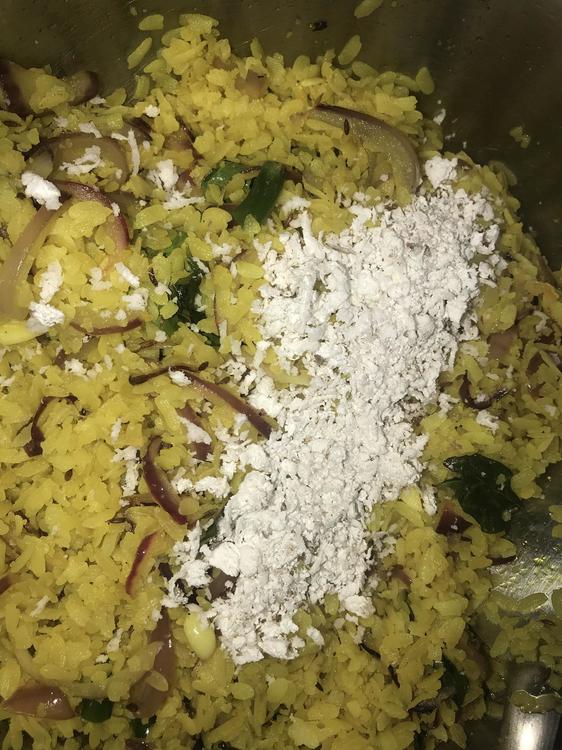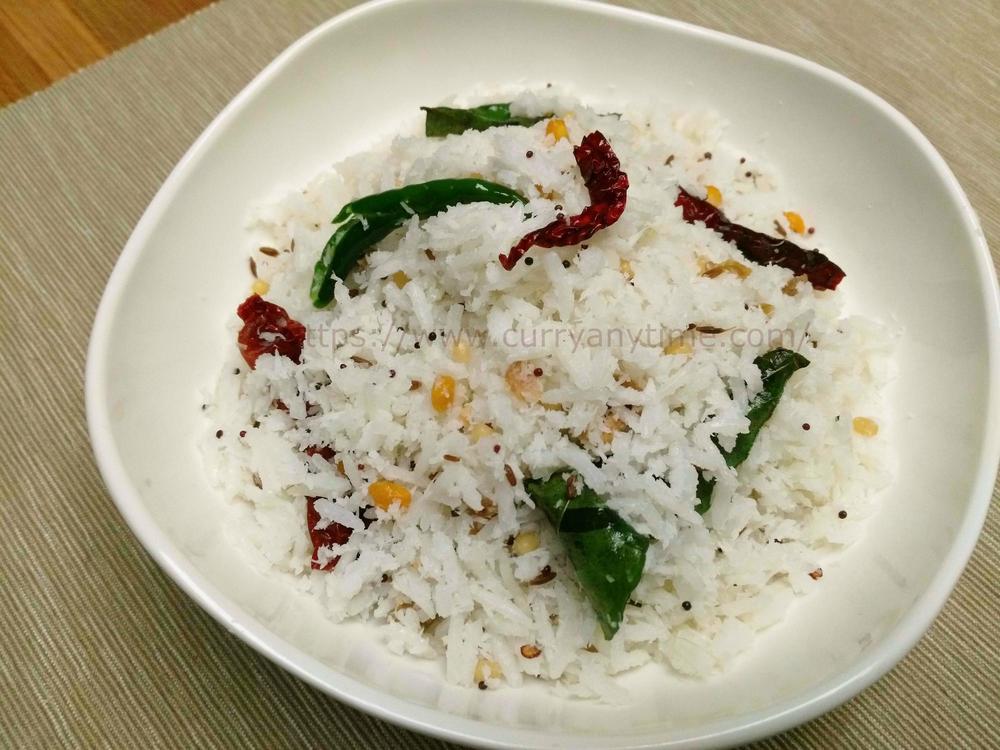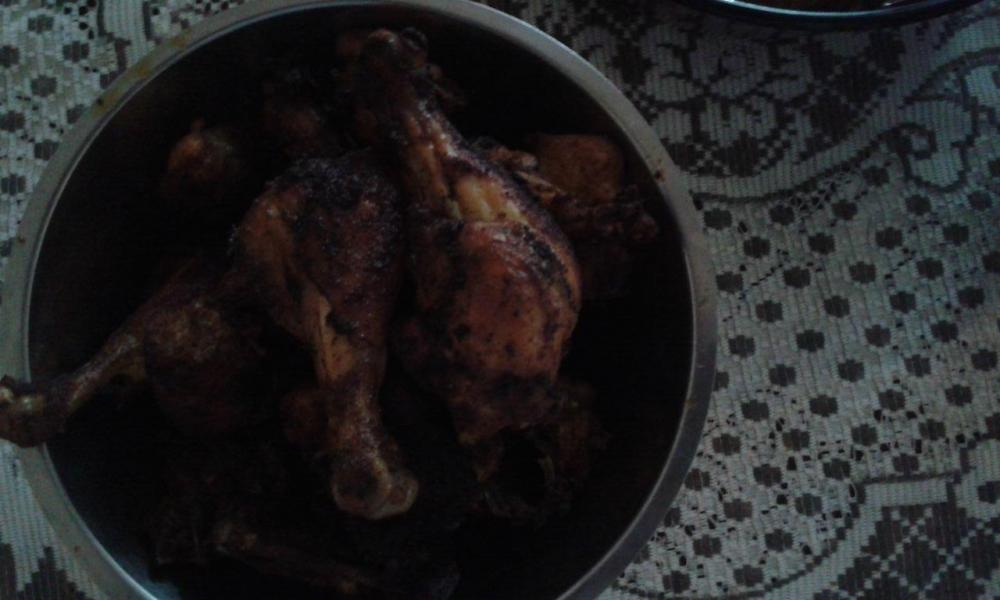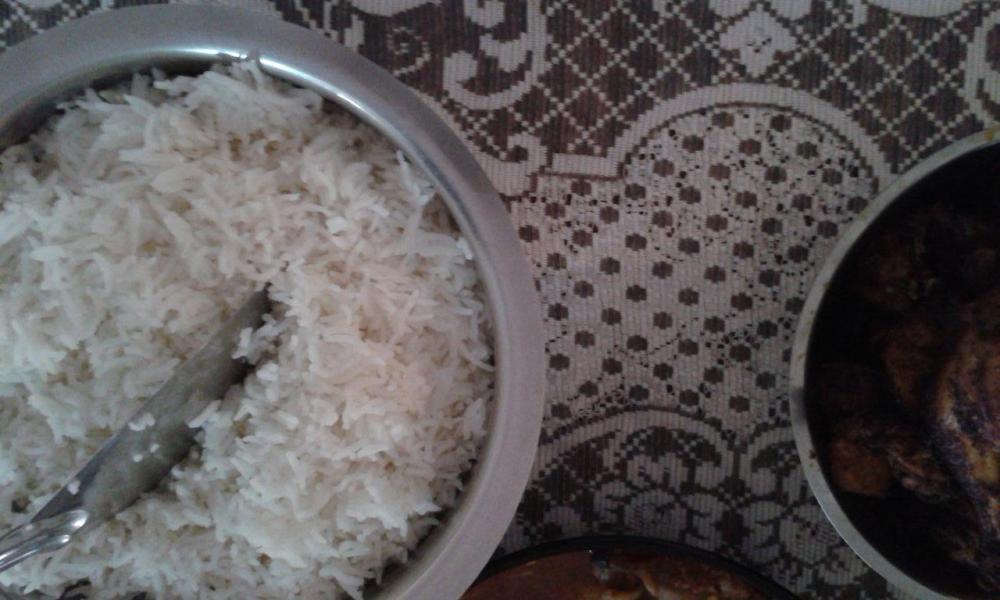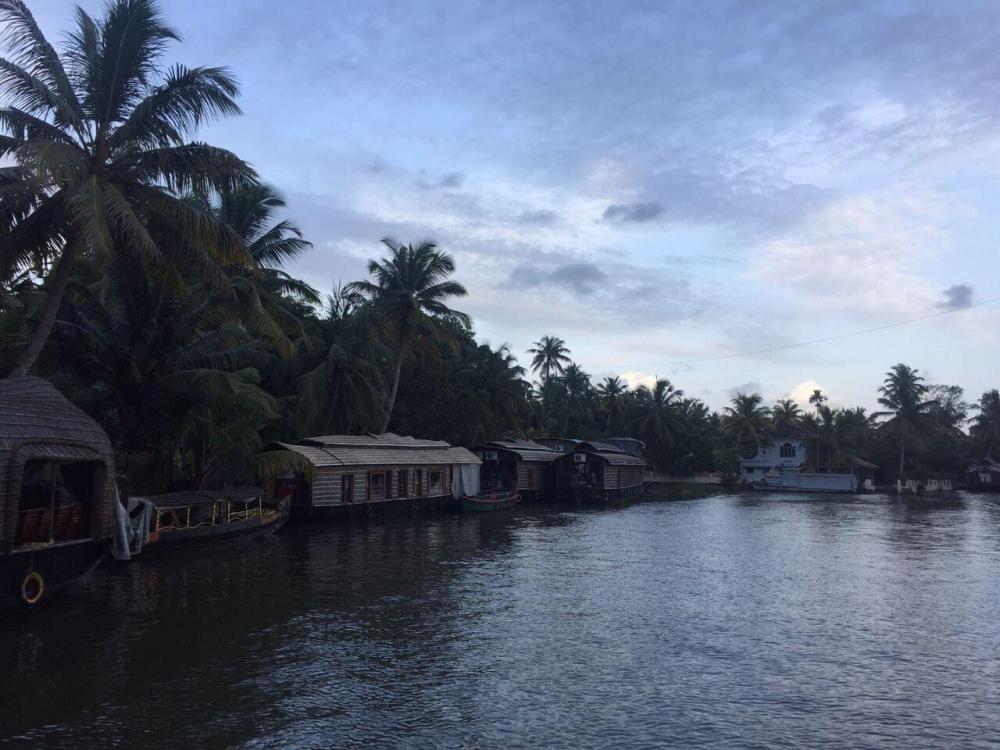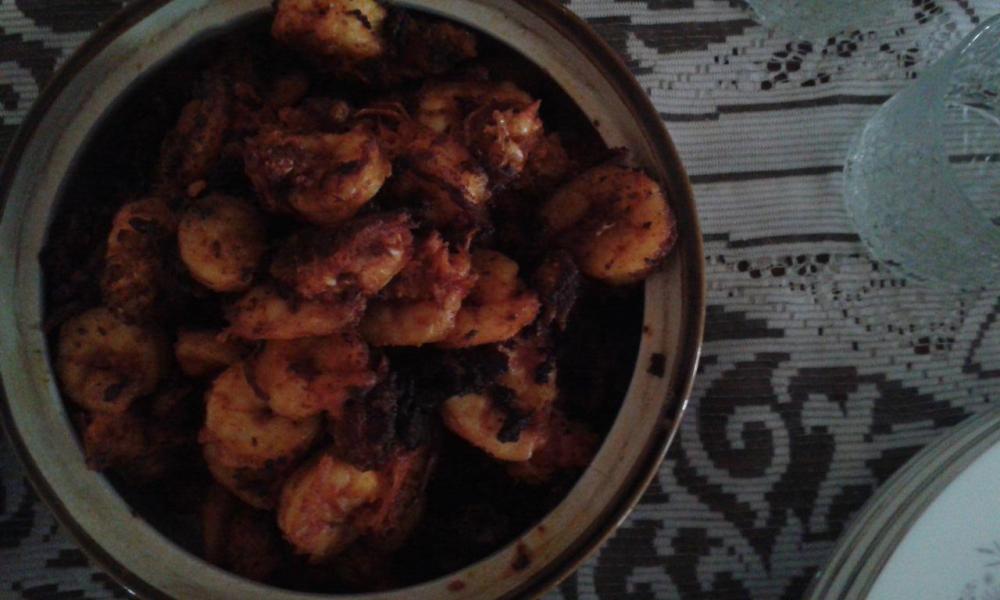Search the Community
Showing results for tags 'Indian'.
-
First, My Commentary Shivaji Rao Holkar is the short form name of Maharajkumar Shrimant Shivaji Rao Holkar of Indore (aka Prince Richard Holkar). Shalini Devi Holkar (Princess Sally Holkar) is the Indian name via marriage of Ms. Sally Budd of Dallas, Texas. They met while being students at Stanford University in Palo Alto, California. Married in 1967. This book was published in 1975. Link+ is amazingly awesome! I didn't know that my local library was affiliated or have membership access free to the public with library card. In addition to my own collection of books, I have been requesting (within reason) books from all over California's public libraries! I have not cooked this recipe...yet! I thought it would be great to share that royal recipes are "relatively easy" and "immensely friendly to the Western kitchens." Filmed at Prince Richard Holkar's residence called Ahilya Fort in Maheshwar in Madhya Pradesh. You can see an excerpt of Prince Richard Holkar talking about his book from a recent video on the YouTube food channel called "Khaane Mein Kya Hai" (What is There to Eat?). Talk starts at around 9:59. Serves: 6 Founder’s Feast The founder of the dynasty, the first of the seven Nizams to rule Hyderabad, was Asaf Jha, for whom this dish is named. A famous general before he became a ruler, Asaf Jha used to say to his men that to hold a fort there must be only a head, two arms, and two legs. By that, he meant a commander, reinforcement from two quarters (the arms), and food and water in the fort (the legs). Food in the fort may have meant rice and lentils for the regiments; but for Asaf Jha himself, there were always elaborate dishes. This kaliya, or saucy meat, was one of his favourites. Rich with saffron, almonds, and raisins, it is the epitome of refined Muslim cuisine. Ingredients 3 cups unflavoured yogurt, beaten smooth with a fork 2 Tbs. minced garlic ¼ cup scraped and minced ginger root ½ cup clarified butter 4 tsp. salt 2 lbs. lean, boneless lamb (preferably shoulder or leg), cut into 2-inch cubes ¼ cup clarified butter or vegetable oil 2 Tbs. seedless raisins ½ cup slivered blanched, unsalted almonds 1 cup coarsely chopped onion 1-2 Tbs. ground hot red pepper 2 tsp. sugar 2-4 fresh, green chili peppers, seeded and minced (optional) ½ tsp. saffron threads ¼ cup minced fresh coriander leaf (cilantro) (optional) Method Three hours before cooking, pour the yogurt into a strainer lined with a double thickness of dampened cheese-cloth and set over a bowl to drip. (One cup of waterless yogurt will be required.) Purée the garlic, ginger, and salt with ¼ cup water in the blender. Rub this purée into the meat. In a heavy, medium-sized saucepan, heat the butter and fry the meat until it is golden and the natural water evaporated. Add 2 cups water and cook uncovered over medium-high heat until tender. (Add up to 1 cup more water as necessary to tenderize.) All the water should boil off before beginning the next step. Set aside off heat when ready. Fifteen minutes before serving, in a very small skillet or saucepan, heat the butter and fry the raisins until they puff. Remove to the meat pot. In the remaining oil, fry almonds until golden. Remove to meat pot. Add enough fresh oil to the skillet to cover the onions and fry them until they are golden and crisp. Drain and add into the meat with all remaining ingredients in this section. At this point, the meat can be held for several hours. Twenty minutes before serving, reheat it gently and complete preparation. Powder the saffron and put to soak in a cup with 2 tsp. hot water. Just before serving, beat this saffron water into the 1 cup reserved waterless yogurt. Stir into the meat with the coriander leaf. Beat through and serve immediately over plain, white rice.
-
By Tan Can Cook Modified and Adapted from Bilkees I. Latif and Pratibha Karan Serves 10 A decadent, slow-cooked boneless chicken with rich, fragrant, creamy gravy, Dum ka Murgh Nawabi is emblematic of the leisure and passion that define Hyderabadi cuisine. Rooted in the Nizami royal kitchens of Hyderabad, Telangana, this dish stands as one of the most elegant in my repertoire—a true “fancy chicken with gravy.” When I cook, it’s not just food for sustenance but exploring, learning, and appreciating the Greater Indian Culture. Hyderabad stands apart as the only South Indian city to rival the refinement and nicety of Lucknow and Rampur, its culinary traditions reflecting centuries of confluence and refinement. Fried Onions / Birista [Yields: 476 g (2¾ Cups) Onion Oil; 192 g Fried Onions] 520 g (3 cups) vegetable oil 785 g (1½–2 large) onions, thinly sliced Charoli-Mixed Melon Seeds-Almond Paste (Ground Into Paste) 12 g (1 tbsp) char magaz (mixed melon seeds) 20 g (2 tbsp) charoli nuts 10 g (8) almonds, blanched 100 g whole plain yogurt Dum ka Murgh Masala (Ground Into Powder) 1 g (6) green cardamoms 0.63 g (6) cloves 3 g (2″) cinnamon sticks 2.25 g (1 tsp) cubeb berry (Piper cubeba) 2 g (¾ tsp) black cumin seeds (Elwendia persica) 3 g (2 tsp) coriander seeds 10 g (1 tbsp) poppy seeds 2.00 g (1 tsp) sandalwood powder, culinary grade (Santalum album) Marination (Overnight) 1.626 kg boneless chicken breasts and thighs, skinned and curry cuts 58 g ghee 96 g (½ cup) onion oil 20 g (1 tbsp) ginger paste 18 g (1 tbsp) garlic paste 1.50 g (½ tsp) turmeric powder Prepared Dum ka Murgh Masala Prepared charoli-mixed melon seeds-almond paste 1.00 g (2 tbsp) dried mint leaves, coarsely crushed 12 g (3 tbsp) fresh coriander, chopped 16 g (2 tbsp) Kashmiri red chili powder or paprika powder 400 g whole plain yogurt 19 g (2½ tsp) fine salt 142 g fried onions Dum Pukht (Slow Cooking) 0.5 g (a large pinch) saffron, soaked in 1 tbsp warm milk (or rose water) and ground Dhungar (Smoking) Piece of live charcoal Half an onion with skin ½ tsp ghee Garnishing Mint sprigs, chiffonade 50 g fried onions Zest of lime/lemon Method Fry onions until dark brown. Drain oil. Keep aside 50 g of fried onions and saffron. Mix the rest of the ingredients for the marinade with the chicken. Leave in the refrigerator overnight. Keep at room temperature for 1 hour before cooking. Add saffron. Place prepared marinated chicken in an oven-proof dish and bake in a preheated oven at 400°F for 45 minutes. Let it rest for 15 to 20 minutes. Before serving, light a piece of charcoal. Put the half-onion with skin inside the dish with ghee in it. Using tongs, pop a burning piece of charcoal in the oil. To catch the fresh charcoal flavor and retain the smoky aroma, cover the dish quickly. Before serving, remove charcoal and spread oil over chicken. Garnish with fried onions and sprigs of mint.
-
I was surprised to learn how many varieties of cardamom there are and how widely they're used. Click on the links below for more details. The Cardamom universe is bigger than you think How to use Cardamom Left to right: green, black, Chinese, white, and Ethiopian cardamoms.
-
Namaskar(am). As-salaam alaikum. Adaab. Sat sri akal. Vanakkam. Nomoskar. Salam! Hello from Northern California (USA). My name is Ronald N. Tan; I am a home cook (personal chef) with a laser-focused culinary interest in regional Indian, Pakistani, Bangladeshi, and provincial Iranian (Persian) cuisines. My aim is to foster and cultivate discussion while disseminating and sharing knowledge on sourcing rare, specialty spices and herbs—compulsory and outside of India—so that recipes from regional Indian cookbooks published in India can be reproduced 1:1, with viable substitutions and minimal omissions. I will be updating this post in “bite-sized” threads. Please consider following or watch this thread for updates and discussion. I am not affiliated with any of the merchants or online stores. In accordance with eGullet forum regulations, the provided links direct to the original sources. They are intended solely as references to expand and enrich our collective knowledge of the culinary arts! As this is my comprehensive and detailed source list, please perform your due diligence. I will not be responsible for any issues encountered, as individual shopping experiences may vary. Spices and herbs should be purchased in whole form whenever possible, stored in airtight glass containers, and kept away from light. To maximize spice potency, slow toast over low heat to activate their essential oils. To achieve finer grounds, sieve using the smallest mesh. Place the larger pieces back into any grinder and repeat as necessary. For handling harder spices and herbs, e.g. dried vetiver roots (Chrysopogon zizanioides / Vetiveria zizanioides), lesser galangal (Alpinia officinarum), or spiked ginger lily (Hedychium spicatum), a heavy-based granite mortar and pestle is necessary. Repeating (2) and (3) as necessary. Support your local South Asian (Desi) and Middle Eastern grocers. Their contribution to enhancing and diversifying our culinary culture is paramount and often understated—source common ingredients locally whenever possible. Establish relationships with the owners and managers of these stores, as they are invaluable sources of insight and can recommend the highest-quality products. Only resort to online sources when local options have been exhausted.
-
As-salaam alaikum everyone. Namaskar(am). Vanakkam. Adaab. Sat sri akal. Greetings from Northern California (USA). My name is Ronald N. Tan, but when cooking, I use my food name of "Tan Can Cook." I would like to start this post and topic for sharing and showcasing the various regional spice blends from India. There is more to spice blends from India than your garam masala, curry powder, etc. I would like to start my post with what I consider to be spice blends that showcases and epitomizes not only India's affluent culinary history, but the collective khansamas and bawarchis culinary creativity. To showcase the complex and layered spice blends, I will share them in the form of mise en place, along with the full recipe of the ingredients. As a masalchi, I am learning and exploring regional spice blends from India, Pakistan, Bangladesh, and Iran. If you have questions or clarifications, please ask in this topic. The recipes are sourced from my personal library of cookbooks sourced direct from India. Lazzat-e-Taam from Dastarkhwan-e Awadh: The Cuisine of Awadh लज़्ज़त-ए-ताम By Tan Can Cook Modified and Adapted from Sangeeta Bhatnagar and R. K. Saxena Ingredients 7 g green cardamom 5 g black cardamom 5 g barberries [Berberis vulgaris] 5 g sandalwood powder, culinary/edible grade [Santalum album] 5 g coriander seeds 5 g lemongrass [Cymbopogon spp.] 5 g cumin seeds 5 g black cumin seeds [Elwendia persica] 5 g cubeb [Piper cubeba] 5 g grated coconut 5 g black pepper 5 g white pepper 5 g poppy seeds 5 g cloves 5 g fox nuts [Euryale ferox] 5 g anise seeds 5 g fennel seeds 3 g mace 1 whole nutmeg 3 g dried rose petals 2 g cinnamon 1 g Indian bay leaves [Cinnamomum tamala] Dried fennel leaves 13 g (1 tbsp) kewra water 11 g (1 tbsp) meetha itr (culinary grade food perfume; I use Deer-brand meetha itr sourced from Kolkata, West Bengal. I don't have any luck finding sellers from Lucknow who would source and ship to the USA) Method Gently roast all dry ingredients over a low flame until fragrant. Remove from heat and grind to a fine powder. Sieve the mixture, then add kewra water and meetha itr. Rub the mixture between your palms and sieve again. If still moist, dry indoors before storing in an airtight jar. Hyderabadi Potli ka Masala from A Princely Legacy Hyderabadi Cuisine हैदराबादी पोटली का मसाला By Tan Can Cook Modified and Adapted from Pratibha Karan Ingredients 50 g coriander seeds 8.75 g dried vetiver roots [Vetiveria zizanioides] 8.75 g Indian bay leaves [Cinnamomum tamala] 8.75 g lesser galangal [Alpinia officinarum] 7.5 g cubeb [Piper cubeba] 7.5 g black stone flowers [Parmotrema perlatum] 6.25 g sandalwood powder, culinary grade [Santalum album] 6.25 g black cardamom 6.25 g whole wheat grains 6.25 g spiked ginger lily roots [Hedychium spicatum] 5 g dried rose petals 3.75 g cinnamon Method Mix these spices and herbs in the given proportions and divide into portions. At the time of use, tie a portion in a muslin cloth or in any thin cloth for insertion in the dish. Use one or more portions as may be required. Store in an airtight jar to prevent insects from getting into the mix. Alternatively, I prefer to ground them into powder and use accordingly in powdered form. Traditionally, they are used as bouquet garni and added into to make broth, flavored water, base, etc.
-
Goan Fish Curry I'm attempting to recreate something not a million miles from the Goan Fish Curry I'd enjoyed on Palolem Beach years ago. The curry used small whole clean fish (approx. 2" to 3"), boned and cooked in the sauce. Is anybody able to recommend a supplier of a suitable fish (i.e. for taste, texture, size, freshness and arrives clean) within London? If so, any recommendations would be much appreciated. Thanks!
-
Cafe Spice Namaste Lamb Dhansak This is the traditional dhansak recipe you can find on the greedy gourmet website https://www.greedygourmet.com/recipes-for-diets/gluten-free/dhaan-saak/ I have compared it to that in Cyrus Todiwala’s Cafe Spice Namaste cookbook, first published in 1988 from where the online recipe originated, and I have corrected the text to rectify any errors and omissions on the website. There is a lot of work to this dish, maybe not for the faint hearted, but if you want to prepare something with the Wow factor for friends and family you could spread the preparation of the various components over several days or even weeks with the aid of a freezer. Ingredients Dhal 100g toor daal 50g channa daal 50g moong daal 100g masoor daal 1 small aubergine, diced 100g pumpkin (peeled weight), diced 2 tbsp coarsely chopped fresh dill 1 colcasia leaf (arbi), if available 50g fresh fenugreek leaves, or 1 tbsp of dried leaves 6 tbsp prepared tamarind pulp or paste or 2 tbsp concentrate 100g jaggery 2 tbsp chopped fresh coriander stalks 2 tbsp chopped fresh mint stalks Salt, to taste For the Wet Masala 5cm piece of cinnamon stick 6 cardamom 6-8 cloves 2 tsp cumin seeds 10 peppercorns 1 heaped tsp coriander seeds 8-10 large dried red chillies 3 x 2.0cm pieces fresh ginger, roughly chopped 10-12 garlic cloves, roughly chopped 30-50g fresh coriander, stalks and leaves Dry Masala 3-4 cardamom pods 3-4 cloves 2-3 star anise 1 heaped tsp cumin seeds 8-10 black peppercorns 2-3 dried red chillies 2 tsp dried fenugreek Lamb 2-3 tbsp oil 500g boned leg of lamb, in 2cm cubes, ask your butcher to saw up the bones and give them to you. 150ml water Chopped fresh coriander and mint to garnish Salt Pulao 5 tbsp vegetable oil 4 onions finely sliced 1 tbsp chopped fresh mint 1 tbsp chopped fresh coriander 2.0cm piece of cinnamon stick 3-4 cardamom pods 3-4 cloves 4-5 star anise 500g basmati rice, washed and drained About 2 tsp salt to taste Kebab 1 onion, very finely chopped Oil for frying 500g fresh lean minced lamb 5cm piece fresh root ginger, very finely chopped 6-8 garlic cloves, very finely chopped 2 green chillies, very finely chopped 1 tsp ground cumin 1.5 tsp ground coriander 0.25 tsp ground turmeric 0.5 tsp chilli powder 2 tbsp chopped fresh coriander 2 tbsp chopped fresh mint 1 tsp lemon juice 3 slices of brown or white bread, soaked in a little water, then squeezed out into a ball Salt to taste Kachumber 1 large onion, finely sliced 2 tsp chopped fresh coriander 10 fresh mint leaves, chopped 1 green chilli, finely chopped 1 small tomato, deseeded and finely chopped 1tsp white vinegar Salt, to taste Instructions Dhal Wash all the pulses and transfer to a large heavy-based saucepan. Add water to cover by 2.0cm, then add all the remaining ingredients and bring to a boil. Reduce the heat and simmer, scraping the bottom of the pan regularly with a wooden spatula. When the lentils are fully cooked, puree the entire contents of the pot until smooth, then cover and set aside. Lamb First prepare the masalas. Wet Masala Heat a large heavy based frying pan or wok, add all the ingredients except the fresh coriander and roast gently for about five minutes, stirring frequently. When the chilies and spices look roasted (i.e., they have changed colour slightly but are not actually discoloured) remove and grind to a smooth paste in a blender, adding the fresh coriander and just enough water to process the mixture. Dry Masala Roast all the ingredients gently in a wok or skillet, stirring regularly. When the spices have changed colour, smell gorgeous and look roasted, remove from the heat and allow to cool. Transfer to a grinder and process into a fine powder. Heat the oil in a large heavy-based saucepan, add the lamb and the bones and sauté on a high heat until the meat is well coloured. Add the wet masala and cook until you see the oil separating along the sides of the pan. Add the 150ml of water, check salt, and cover tightly and cook on a medium heat for 40-45 minutes, stirring regularly and adding a little more water if it looks too dry. When the lamb is cooked and you have a nice thick, rich gravy, stir the mixture into the puréed dhal. Add half of the dry masala then taste. If it is to your liking, save the rest of the masala to serve with other lamb dishes. Or add the rest of the masala, a little at a time, tasting as you go. This is your Sak. Pulao Heat the oil in a large pan and add half the onions, fry until crisp and golden. Drain well on kitchen paper and set aside with the mint and coriander, they will be used to garnish the rice just before serving. Add the spices to the casserole and cook over a fairly high heat for 2 minutes, stirring until dark and swollen. Add the remaining onions and cook gently, stirring frequently until they are a deep brown colour. Add the rice and cook over a medium heat for 5-6 minutes, turning the rice regularly so that all the grains are evenly heated. Add the salt, the pour in enough hot water to cover the rice by 2.0cm. Stir for a minute, cover tightly and cook over a very a low heat for 15 to 20 minutes. Check on the rice every now and again, stirring from the bottom up with a flat wooden spatula. If you need more water add it a little at a time. The pulao should take approximately 15-20 minutes to cook. When the grains are cooked, set aside but do not uncover the pot. Sheek Kebabs Fry the onion in 1 tablespoon of oil until soft. Remove from the heat and leave to cool. Mix with all the other ingredients in a large bowl until thoroughly blended. Cover the mince mixture and chill in the refrigerator. Roll the lamb mixture into 2.5cm (1in) balls. Deep fry the kebabs or, if preferred, place them on a greased baking sheet and bake in an oven preheated to 200°C/400°F/gas mark 6 for about 20 minutes Kachumber Mix all the ingredients in a bowl. Serving the Dhansak Reheat the rice, lamb and kebabs if necessary. Garnish the Pulao with the fried onions, mint and coriander, then dot with the kebabs over the top. Garnish the Sak (meat and lentils) with chopped fresh coriander and mint. Serve Kachumber on the side.
-
This is my take on a Lamb Bhuna, initially inspired by an Anjum Anand recipe, with some amendments to the ingredients and a couple more steps to the cooking process in line with other Bhuna recipes I have cooked over the years. If you prefer a milder curry remove or reduce the chillies from the initial paste. I tend to drastically reduce the sauce at the end until it is very thick, but if you prefer more sauce do not reduce as much. Lamb Bhuna by Tempest63 Ingredients 2 large tomatoes, quartered 30g ginger, peeled, roughly chopped 8 large garlic cloves, peeled, roughly chopped 2-4 green chillies 6 tablespoons vegetable oil 1kg diced boneless lamb shoulder 20 black peppercorns 2 Tej Patta (Indian bay leaves) 5 cloves 2” stick cinnamon 4 green cardamom pods 2 black cardamom pods 2 large onions, roughly chopped 2 tsp ground cumin 1 tbs ground coriander 2 tsp garam masala 1 tsp Kashmiri red chilli powder 250 ml stock (lamb or beef) home made is best if available Juice of half a lemon 1 cup coriander leaves Method Put tomatoes, ginger, garlic and chillies in a blender with 1 to 2 tablespoons of water and process to a smooth paste. In a non-stick pan heat half the oil over a high heat and brown the lamb, in batches, for 4-5 minutes, getting a good colour on all sides. Remove the lamb from the pan with a slotted spoon and set aside. Heat the remaining oil over a medium heat add the whole spices and onions. Cook stirring occasionally for 10 minutes or until the onion is well browned. Return the lamb and any collected juices to the pan with the ground spices and stir until the spices lose their raw aroma, add the tomato/ginger/garlic/chilli paste, bring to a boil, then reduce heat and simmer stirring regularly for 15-20 minutes, until the liquid is reduced by half. Increase heat to high and stir fry until all the excess moisture has evaporated. This really intensifies the flavours. Add the stock, bring to the boil and cover with a lid. Reduce heat to low and simmer for another 20-30 minutes, or until the lamb is tender. Uncover and raise the heat until the sauce has thickened and coats the meat. Add the lemon juice and season to taste. Serve topped with the chopped coriander.
-
It's been 5 long years since we last went to Kerala, which I wrote about here. That was to celebrate my niece's wedding. This time we're back on the occasion of the rice feeding ceremony for the couple's 5 month old son. It won't be as big a do as the wedding but it will be a more intimate gathering. So here is my first lunch in my mother's kitchen. Rice, yellow daal, pan-fried mackerel and a mackarel curry. In the background is some fried chicken and a green lentil daal. I never asked for nor touched the fork, honest!
-
This almost had me in tears of nostalgia. My London home is a few minutes walk from here and I love the place. So glad to hear it seems to be being protected from developers, as I had heard it was under threat. Wonderful food, too. Mostly vegetarian, which I'm decidedly not, but will happily eat from time to time. London's most authentic Indian food?
-
- 2
-

-
Breakfast in India vs Breakfast in our homes outside India My breakfasts have varied from the time I started to cook for myself instead of just enjoying my Mother’s cooking. At first they were a mix-match of meal fixings, or just dinner leftovers. Or the good old breakfast cereal and milk. But as the years passed and I was more organized, the meals I enjoyed in my Mother’s home began to swim in my memories. And I began to prepare those for my family. However, I am no amazonian chef, so depending on the hectic nature of the days plans, I switched back and forth from convenience with taste, to elaborate and of course tasty breakfasts. We do have both vegetarian and non vegetarian foods but Indian breakfasts will mostly be vegetarian. So here are some of the things I might make: 1. Poha as in mostly ‘kande pohe’. 2. Cheela/ Pudla 3. Masala toast 4. Indian Omelette 5. Handwo piece 6. Thepla 7. Vaghareli rotli 8. Dhokla chutney 9. Idli sambhar 10. Leftover sabji 11. Muthiya 12. Khakhra 13. Upma 14. Paratha 1. Kande Pohe: The dish derives its name from Maharashtra where the Kande Pohe are celebrated as breakfast. They can of course like any breakfast, be eaten at any time. Pohe/ Poha are steamed rice grains that have been beaten flat and then again redried. So they are like Rice flakes. Except they are hand pounded, so have a knobbly texture. You get several varieties in the market. I prefer the thick white variety. 1 cup dry poha per person 1 medium onion sliced 1/2 jalapeno deseeded 1 sprig curry leaves 2 small garlic cloves 1/4 t cumin seeds 1/2 lemon 1/8 t asafoetida 1/4 t turmeric small handful of cilantro leaves 1T fresh grated coconut 2 T Peanut oil salt to taste sugar to taste In a pan heat some oil and add cumin seeds. When the seeds sputter, add sliced onions and stir. Saute on medium heat till they turn slightly browned here and there. Do not burn the onions. Meanwhile wash the Poha in a colander and drain. Do this two or three times to get rid of any dirt and also to allow them to rehydrate. They do not need soaking. Fluff the poha with a fork. Add salt sugar turmeric asafoetida and chopped cilantro. Mix and set aside. Once the onions are ready add minced garlic and chopped jalapeno along with the curry leaf sprig. Turn the heat to low and add the poha mixture. Stir to coat and to allow the turmeric and asafoetida to cook. The poha will turn mildly yellow and start giving a wonderful fragrance. Turn off the heat. Fluff gently and plate. Garnish with fresh grated coconut and a squeeze of lemon juice. Finger licking good!! Now when I make this next I will post a picture. Update: Ok I felt the urge to have Kande Pohe for tonight’s dinner. So here is a picture. I am certain to enjoy it for breakfast as well. The measurement of 1 cup poha per person is too much for one meal. But carried over to another meal thats super good! I will also have some stir fried bok choy greens made in the same kadhai after the poha was done, and some cooked and sliced beetroot for salad. My family will add some haldiram sev on the poha for extra crunch! And we will all have some chaas to round off this meal. ************* 2. Cheela/ Pudla These are essentially crepes but in the Indian style. 1/2 cup sieved garbanzo bean (Besan) flour. Water to form a thin batter 1T plain yogurt 1/2 t ginger garlic paste 1/4 or less green chili crushed 2 t heated oil * pinch asafoetida pinch turmeric salt to taste chopped cilantro (two sprigs) some ‘masala’ from a readymade pickle Method: mix the ingredients together except oil. Heat oil in a separate pan and add about 1 to 2 t of the hot oil onto the batter. It will sizzle. Use a whisk to stir thoroughly. The batter should be pouring consistency. Let the batter soak for about half an hour if possible. On a hot griddle, pour a ladle full of the batter. Turn the griddle with your wrist to spread the batter around. Cook on moderate to high flame. Flip the crepe when all the sides look like they are ready. You can add a little oil to the sides of the frying pan to make the edges crispy. In my home we usually have a Besan cheela with some yogurt its a quick and filling breakfast. You can have a small salad or fruit with it to make it more complete. Or fill the center of the cheela with some cottage cheese and fold for added creaminess! **************** 3. Masala Toast : 1 slice of bread (your choice) toasted 1/2 small red onion minced 1 medium roma tomato diced (or whatever you have) cilantro (few leaves) 1/8 t cumin (optional) 1/4 t chaat masala ( available in stores) 1 inch cube paneer 1 T peanut oil pinch turmeric (optional) Heat the oil in a pan and saute the onions. Add the tomato and cook down to mush. Crumble the paneer and add the dry spices. Stir for a few seconds to warm the paneer. Add the cilantro and though I have not written it as an ingredient, I like a few drops of lemon juice. Do not overcook paneer. I started this topic because someone asked for Indian recipes on the new forum. I don’t think they have seen any yet. I hope they find this useful. I am enjoying it. ************************** I will add recipes to the list slowly. I have to however add that after a certain ‘age’ I have now resorted to having to make sure I have three things for breakfast besides coffee: a glass of water, a small portion of fruit and a small portion of some protein not necessarily meat. Bhukkhad
- 19 replies
-
- 5
-

-
This is one of my daughter favorite dishes, being mild and less spicy she loves this rice dish. Its super easy to make and goes well with most Indian curries. Do try this out and I am sure you will be happy with the results. Prep Time : 5 mins Cook Time: 5 mins Serves: 2 Ingredients: 1 cup rice(basmati), cooked 1/2 cup coconut, shredded or grated 1 green chili, slit 1 dried red chili 1 1/2 tablespoon oil/ghee(clarified butter) 1/2 teaspoon mustard seeds 1/2 teaspoon cumin seeds 1/2 tablespoon chana dal(split chickpeas) 1/2 tablespoon urad dal(split black gram) 1 teaspoon ginger, finely chopped A pinch of hing (asafoetida) Few curry leaves Salt to taste Directions 1) Heat oil/ghee(clarified butter) in a pan in medium flame. I used coconut oil here because it tastes best for this dish. 2) Add mustard seeds, cumin seeds, chana dal(split chickpeas), urad dal(split black gram), green chili, dried red chili, ginger and curry leaves. Fry this for 30 seconds in medium flame. The trick is to ensure that these are fried but not burned. 3) Add a pinch of hing(asafoetida) and mix well. 4) Now add the cooked rice and coconut. Stir well for about 15 to 20 seconds and switch off the flame. 5) Finally add salt into this and mix well. You could add peanuts or cashew nuts if you prefer. Goes well with most curries.
-
- 4
-

-
- Indian
- Vegetarian
-
(and 1 more)
Tagged with:
-
Prawn Balchao is a very famous Goan pickle that has a sweet, spicy and tangy flavor to it. For the balchao paste you will need: > 8-10 kashmiri red chillies > 4-5 Byadagi red chillies > 1/2 tsp cumin seeds > 1/2 tsk turmeric powder > 1 tsp peppercorn > 6 garlic cloves > 1/2 tsp cloves > 1 inch cinnamon stick > Vinegar First you will need to marinate about 250 grams of prawns in some turmeric powder and salt. After 15 minutes deep fry them in oil till them become golden n crisp. Set them aside and add tsp vinegar to them and let it sit for 1 hour. Now, make a paste of all the ingredients mentioned under the balchao paste and make sure not to add any water. In the same pan used for fryin the prawns, add in some chopped garlic and ginger. Lightly fry them and immediately add one whole chopped onion. Next, add the balchao paste amd let it cook for 2-3 minutes. Add in the prawns and cook until the gravy thickens. Finally add 1 tsp sugar and salt according to your taste. Allow it to cool. This can be stored in a glass jar. Let this mature for 1-3 weeks before its use. Make sure never to use water at any stage. This can be enjoyed with a simple lentil curry and rice.
- 5 replies
-
- Condiments
- Indian
-
(and 1 more)
Tagged with:
-
Goa being one of the popular cities of India is known for its local delicacies. These delicacies have been passed on from generation to generation, while some of them have continued to remain popular, some of them have lost their charm with the introduction of newer cuisines. Since the Portuguese entered Goa, they have had a strong influence on the local cuisine. A major turning point came when they introduced a variety of spices that changed their style of cooking completely. The Portuguese introduced plants like corn, pineapple, papaya, sweet potato and cashews. One such example of a popular dish would be Pork Vindaloo. Goan food is a mix of hot and sour ingredients that make their seafood delectable. Kokum is one such ingredient which is known to be a tangy-sweet fruit. It is added in curries to render a sour taste and is often accompanied with seafood. Dried red chillies are one the most vital ingredients common among all the local delicacies that is either used in its whole form or ground into a fine paste. Since seafood is the soul of Goan food, it is preserved and relished in other forms too. Goan pickles are known to be quite famous. Prawn Balchao, a very famous prawn pickle prepared with dried red chillies is relished with a simple lentil curry and rice. Another delicacy is the Goan Para Fish made with mackerels, red chillies and goan vinegar. These are regular accompaniments with their routine meals. When talking about Goa, you cannot not mention their sausages. These mouth-watering and spicy sausages are made with pork and a variety of spices. Last but not the least, is the widely famous Goan bread, locally known as Poi. Leavened bread which is part of almost every meal and eaten with plain butter too. These ingredients make the cuisine extremely palatable and continue to make this cuisine stand out from the rest.
-
A few weeks ago I checked out a copy of Madhur Jaffrey's Vegetarian India from the library, and it is well on its way to earning a permanent place in my collection. I've really enjoyed the recipes I've cooked from it so far, and thought I'd share a few of them here. Of course, if anyone else has cooked anything from the book please share your favorites here, too. To kick things off, something that appears in nearly every meal I've cooked this month... a yogurt dish such as Simple Seasoned Yogurt, South Indian-Style (p. 324)
- 95 replies
-
- 8
-

-
- Vegetarian
- Indian
-
(and 1 more)
Tagged with:
-
As a tandoor is not a regular BBQ but an oven which walls need to be hot in order to cook I was wondering if I could use a charcoal chimney to light it. Firstly, I don't know how long it would take for the walls to heat up (I guess quite quick) but secondly (and most important) will the walls crack because of the sudden change in temperature? Any experiences here?
-
My niece has just married and we are in Kerala as part of the celebrations. I wish I could have preserved the whole event in detail for eGullet, as I’ve enjoyed the posts of others so much. In particular I’m thinking of @chefmd's Mongolia blog and @sartoric's amazing South Indian report. Forget that standard! I’m going to try a little mini-blog. Not only am I terribly disorganised and IT challenged but I am also currently suffering from a rotator cuff tear which makes photography painful and difficult. Even though this will be a very scanty record, I think I can offer something a little different to what we've seen before. Prawn fry. Chicken fry. Rice. My mother used to send us off to school with our lunch of fried prawns, rice and yoghurt. I think this rice is basmati, which is not quite correct. The yoghurt is home made daily. The prawns are from the Kerala backwaters; large and fresh caught. These are spiced mainly with chilli paste, and cooked in coconut oil to a somewhat firmer consistency than would be considered polite nowadays in the UK. This combination takes me right back to kindergarten tiffin. The nuns used to roll their eyes and tut at how red and hot the prawns looked. We don’t get it much or at all any more when we’re back in England, so this was an absolute treat. The chicken fry and chicken curry (just pictured with the rice) would normally have been stars in their own shows, but got hardly a look-in today. The thoran (again not pictured) being vegetarian, was sadly neglected. I’m sure it was very good but vegetables really have to fight for their space on my plate. Please bear with me for the misalligned pictures, varying resolution and clunky editing...
-
I make this a lot. Traditionally served with dosa, but great with all kinds of Indian food, even just scooped up with bread or pappads for a snack. Although it's slightly different every time, depending on the tomatoes and chillies used, plus the strength of the tamarind, it's easy, quick to make and always delicious. In a blender - half a medium red onion chopped, 7 dried red chillies broken up a bit, 2 ripe tomatoes chopped, 1 tsp of sea salt, 3 tsp tamarind paste. Whizz until purée like about 2 minutes. In a sauté pan over medium heat add 60 ml sesame oil (gingelly), when it's hot but not smoking add 1 tsp black mustard seeds. Quickly cover the pan to prevent escape and sizzle for a minute. Add 1 tsp of urad dal (black lentils, skinned and split they are light grey). Fry until golden, another minute or so. Throw in about 20 curry leaves. These splatter so cover the pan again. Lower the heat and add the blender contents. Simmer, stirring frequently for about 10 minutes, until you get a runny jam consistency. Ta da !
-
Every now and again I come across a recipe that is awesome. It started with a discovery in my local South Indian take away near work. This is a true South Indian place, not your usual run of the mill Indian restaurant which we get around here. In the bain marie was a red, slightly oily, dry spiced chicken dish scattered with onions and green coriander. A dish with no name. I asked what it was, and they replied it was "spicy chicken". I bought some and I was hooked. It was obviously a favorite of patrons as there was never a day when this dish was not in the bain marie and it sold out quickly. Here is my take on that recipe, which I believe is called Double Chilli Chicken. Apologies in advance, but I dont work to quantities when cooking. Hopefully you can make your own judgement but just ask if you want more clarification. The ingredients you will need are: - oil or ghee (mustard oil if my wife is giving me grief over health, ghee for best flavor) - Chicken mini drumsticks (about 1kg) - About 3 brown onions, cut in half and then sliced (red onions would be better, but I only had one for garnish) - Salt - About 20 curry leaves - Sliced ginger - Sliced garlic - 10 to 15 whole dried chillies (I remove most of the seeds) - Ground dried chilli powder (medium hot) - Ground coriander - Ground black pepper - Jaggery or Palm Sugar - Lime juice - Chopped fresh coriander for garnish - Chopped red onion for garnish I start with a heavy base fry-pan that has a fitted lid and add the ghee. Choose a dried whole chilli of your liking and remove most of the seeds, as they can burn and become bitter. Saute your dried chillies in the ghee for a few minutes You will notice they start to darken quickly Don't let them burn, but take them a bit darker than shown in the photo above and then remove into a spare bowl to cool with a slotted spoon. You can leave the ghee and seeds. Quickly add the onions to stop the remaining seeds from burning. Add salt to help the onions cook. I should have also added the curry leaves to the oil first, but I forgot so I added them later. As the onions soften on the heat, finely julienne some fresh ginger and slice some garlic. Exact quantities dont matter so adjust to your preference. Add the garlic, ginger and chillies to the pan once the onions soften and take on some colour After a few minutes of cooking out the garlic and ginger, add the ground coriander and chilli powder. Again, exact quantities don't really matter but I used about 1 Tablespoon of each. What matters more is the quality of the ground powders. The coriander is ground in my coffee grinder just before use, and I make my own chilli powder from dried Spanish Padron chillies I grow each summer. If you can, always make your own ground spices. For the ground chilli powder, remove the seeds before grinding as you will get a redder product. A quick word on chillies : There are hundreds of varieties, but I choose the Spanish Padron due to the balance between heat and flavour. I want an intense chilli flavour without searing blow your head off heat, and this chilli has that right balance. Stir the powders into the onions and cook for a few minutes. Add the chicken and arrange such that the chicken has good contact with the bottom of the pan. We need this to get the meat to release its own moisture, which is what makes the sauce and prevent the dish from burning Cover with a lid and lower the heat. After 5 minutes you should notice some liquid from the chicken. This increases to a maximum around 15 minutes. Stir every 5 minutes but don't remove the lid until 15 minutes have elapsed. While the chicken is cooking, prepare some jaggery or palm sugar and squeeze the juice out of one lime. After 15 minutes of cooking with the lid on, remove the lid, add the jaggery and lime juice, and now increase the heat. What we are going to do is evaporate the remaining liquid and turn it into an awesome sauce that sticks to the chicken. For another 10 minutes, you will need to pay careful attention to ensure the dish does not stick and burn. You need high heat to help caramelize the sauce and constant movement. Taste for seasoning. Add extra salt, lime juice and heaps of black pepper. Prepare some slived red onions for garnish. And some roughly chopped green coriander. This stuff grows like a weed in my garden as I let the kids loose with the seeds and they scatter them far and wide! Serve the chicken on a bed of steamed basmati rice And garnish with onion and coriander. Serve and enjoy with a glass of cold beer. Awesome stuff! Cheers Luke
-
We're 50 something Aussies who enjoy travelling, eating, cooking, markets, kitchen shops, cooking utensils, animals & plants (often food related), architecture & photography (both kitchens and food) and exploring different cultures (of which food is a big part). The trip was January 14 - February 6, it was just marvellous. My favourite meal is now masala dosa with sambar, I had many. Here's some highlights of the food. A late afternoon snack of Sichuan pepper squid was washed down with a beer at the Ajantha Seaview Hotel on the promenade in Pondicherry. It's a colonial building with a first floor terrace overlooking the colourful display of women in their finest, and the Bay of Bengal. We're here on a Monday public holiday for the Pongal festival, a four day celebration of the harvest, with many different ceremonies and traditions. A visual bonus, cows (and sometimes goats) get their horns painted and wear flower garlands or other decorations.
-
Hi There, I came across this term, Bunooing, which I'd never heard before. I had a look around to try and understand the method behind it, but came across a number of inferences on what bhunooing is and how it works, some of which were conflicting and a little confusing. I would be very grateful if someone could clear this up for me and perhaps answer a few questions. This is my understanding of bhunooing so far:- Essentially, this is a method of releasing essential oils that are cooped up in your dry spices and leaves too. The types of spices used are the hard spices such as cumin seeds, cloves, cinnamon, mustard seeds etc. As I understand it powdered spice can be added, but nearer the end of the bhunooing process. The thinking behind this method is that spices take on moisture over time which dilutes the essential oils in the spices. By slow frying the spices you are gently evaporating the water and releasing the concentrated essential oils from the spice which enhances the power of spice, giving it more punch. The bhunooing process can be used to make a vibrant base for your gravy. To do this, heat a good amount of oil on high and then bring it down to a medium heat. Add your spices and onion and slowly fry until the onion turns a light brown. At this point add your liquid/ gravy. Some questions that I have are:- Why heat the oil to hot and bring to medium? Why not just heat to medium?Does bhunooing always have to include onions?The first time I tried this, the onions absorbed all of the oil after a while - is this okay? Or does it mean that I used too much oil?Is this the same, or does it have any relation to the bhuna?I have come across articles and recipes that refer to bhunooing and suggest that it's (perhaps) just the process of slow cooking ingredients on a flame/ hob - is this correct?How long should I be frying the spices for?I would be very grateful for any help you can provide. Thank you in advance Phill
-
I'm thinking of buying a wet spice/curry paste grinder. Any ideas on what brands are the best? Premier super-g, Preethi ??
-
hi all. just started making paneer and i've read a recipe where you can use the old whey from a previous batch to seperate the whey from the curds in a new batch. i used lemon juice for the first batch. i've since used that whey for a new lot and it's turned out a lot more tender (kind of like philly). anyone know how many time the old whey can be used? not sure about bacteria etc. hope this makes sense cheers
-
Hi, I just want an Indian perspective on this topic for a couple of questions. I know that Hyderabad biryani was the most recognized biryani and I will be going to Indian really soon. Here a Video that I found on YouTube about Hyderabad biryani https://www.youtube.com/watch?v=GhajwFlquPk Questions: 1. Why did they put so many ingredients in the process of making it? 2. Why did they put curd in the biryani? 3. Why did they put in white rice on top and not mixed? 4. Why did they pour hot water in the chicken?


